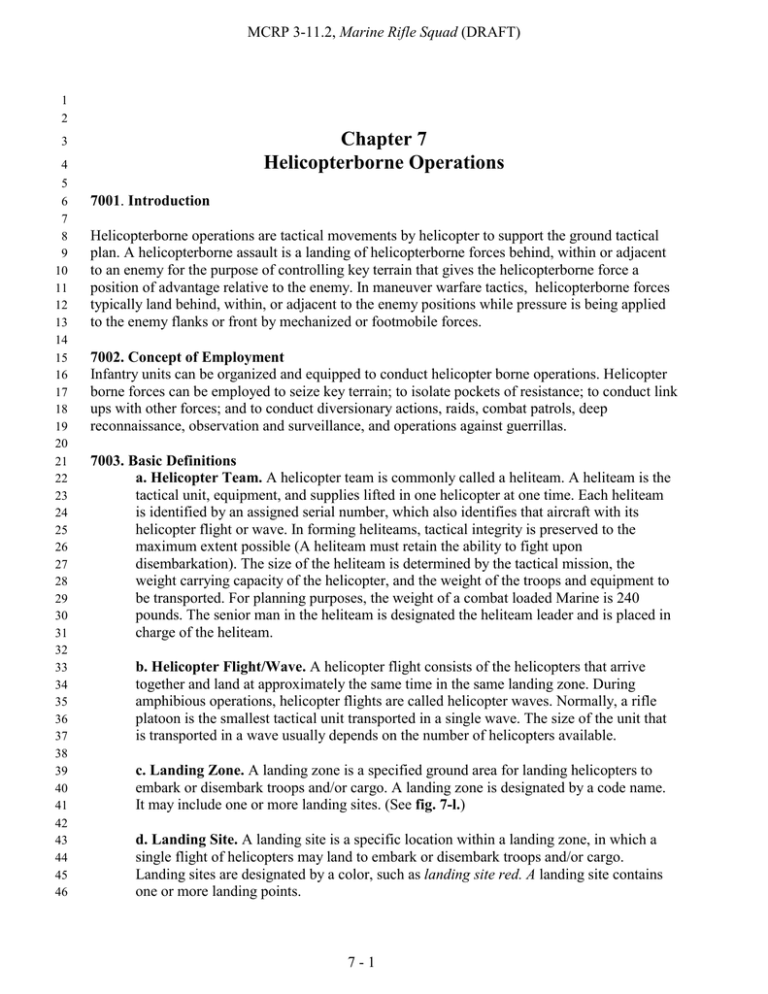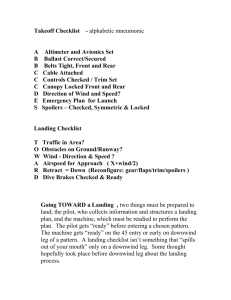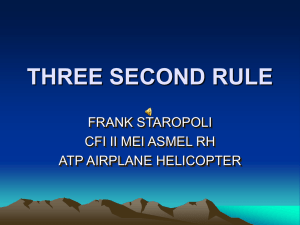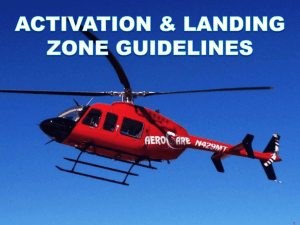Chapter 7 Helicopterborne Operations
advertisement

MCRP 3-11.2, Marine Rifle Squad (DRAFT) 1 2 Chapter 7 Helicopterborne Operations 3 4 5 6 7 8 9 10 11 12 13 14 15 16 17 18 19 20 21 22 23 24 25 26 27 28 29 30 31 32 33 34 35 36 37 38 39 40 41 42 43 44 45 46 7001. Introduction Helicopterborne operations are tactical movements by helicopter to support the ground tactical plan. A helicopterborne assault is a landing of helicopterborne forces behind, within or adjacent to an enemy for the purpose of controlling key terrain that gives the helicopterborne force a position of advantage relative to the enemy. In maneuver warfare tactics, helicopterborne forces typically land behind, within, or adjacent to the enemy positions while pressure is being applied to the enemy flanks or front by mechanized or footmobile forces. 7002. Concept of Employment Infantry units can be organized and equipped to conduct helicopter borne operations. Helicopter borne forces can be employed to seize key terrain; to isolate pockets of resistance; to conduct link ups with other forces; and to conduct diversionary actions, raids, combat patrols, deep reconnaissance, observation and surveillance, and operations against guerrillas. 7003. Basic Definitions a. Helicopter Team. A helicopter team is commonly called a heliteam. A heliteam is the tactical unit, equipment, and supplies lifted in one helicopter at one time. Each heliteam is identified by an assigned serial number, which also identifies that aircraft with its helicopter flight or wave. In forming heliteams, tactical integrity is preserved to the maximum extent possible (A heliteam must retain the ability to fight upon disembarkation). The size of the heliteam is determined by the tactical mission, the weight carrying capacity of the helicopter, and the weight of the troops and equipment to be transported. For planning purposes, the weight of a combat loaded Marine is 240 pounds. The senior man in the heliteam is designated the heliteam leader and is placed in charge of the heliteam. b. Helicopter Flight/Wave. A helicopter flight consists of the helicopters that arrive together and land at approximately the same time in the same landing zone. During amphibious operations, helicopter flights are called helicopter waves. Normally, a rifle platoon is the smallest tactical unit transported in a single wave. The size of the unit that is transported in a wave usually depends on the number of helicopters available. c. Landing Zone. A landing zone is a specified ground area for landing helicopters to embark or disembark troops and/or cargo. A landing zone is designated by a code name. It may include one or more landing sites. (See fig. 7-l.) d. Landing Site. A landing site is a specific location within a landing zone, in which a single flight of helicopters may land to embark or disembark troops and/or cargo. Landing sites are designated by a color, such as landing site red. A landing site contains one or more landing points. 7-1 MCRP 3-11.2, Marine Rifle Squad (DRAFT) 1 2 3 4 5 6 7 8 9 10 11 12 13 14 15 16 17 18 19 20 21 22 23 24 25 26 27 28 29 30 31 32 33 34 35 36 37 38 39 40 41 42 43 44 45 46 e. Landing Point. A landing point is a point within a landing site where one vertical assault aircraft can land. Landing points are designated by two digit numbers, such as landing point 12. (See fig. 7-l.) Figure 7-1. Helicopter Landing Zone. 7004. Helicopterborne Operations Training The objective of helicopterborne operations training is to familiarize personnel with its techniques and ensure that these operations are conducted with maximum speed, flexibility, and timeliness. a. Heliteam Organization. Heliteams are organized as follows: · Heliteam leader. · Assistant heliteam leader. · Remaining members of the heliteam and their equipment. b. Heliteam Leader's Responsibility. The senior commissioned or noncommissioned troop officer of the heliteam is the heliteam leader. His responsibilities are as follows: · Inspect each individual for proper uniform, equipment, and proper adjustment of equipment while in the assembly area. · Muster and organize the heliteam in the assigned assembly area. · Ensure that equipment assigned the heliteam is properly located before the team is called to the holding area or pickup zone. · Lead his heliteam from the assembly area to the holding area, pickup zone, and loading point. · Supervise enplaning of his heliteam. · Supervise deplaning of heliteam personnel and equipment at the landing site. c. Assistant Heliteam Leader's Responsibility. The second commissioned or noncommissioned troop officer is the assistant heliteam leader. He assists the heliteam leader. He must be thoroughly familiar with all duties of the heliteam leader and assumes leadership when necessary. d. Loading Procedure. Troops will be assembled into an assembly area. Here orders are issued and administrative matters are completed. Troops are assembled into heliteams and briefed. When directed, the heliteams are moved to the holding area. The assembly area may also serve as the holding area. From the holding area, heliteams are moved to a pickup point within the pickup zone. (See fig. 7-2.) 7-2 MCRP 3-11.2, Marine Rifle Squad (DRAFT) 1 2 3 4 5 6 7 8 9 10 11 12 13 14 15 16 17 18 19 20 21 22 23 24 25 26 27 28 29 30 31 32 33 34 35 36 37 38 39 40 41 42 43 44 45 46 Figure 7-2. Pickup Zone Operation. e. Loading. Loading is conducted with the maximum speed commensurate with safety. Specific procedures for loading, by type of aircraft and according to the situation, will be prescribed in local SOPs. To assist in loading drills, the following procedures may be used as guides: (1) On signal from the pickup zone control officer or NCO in the pickup zone, the heliteam approaches the aircraft on the double with the heliteam leader leading and the assistant heliteam leader bringing up the rear. (2) The heliteam leader ensures that team members are in proper sequence within the column to facilitate rapid loading of personnel and equipment. (3) Upon reaching the entrance to the aircraft, the heliteam leader takes a position outside, slings his rifle, and assists team members in loading. (4) Personnel enter the aircraft carrying rifles in their hands. (5) The passenger manifest is passed from the heliteam leader to the troop loading assistant within the pickup zone control team. See (MCWP 3-11.4) Tactical Fundamentals of Helicopterborne Operations, for details concerning passenger manifesting. (6) When seated, each Marine places his rifle between his knees, fastens his safety belt, and raises his right arm to signal the heliteam leader that he is ready for takeoff. (7) When the heliteam is strapped in and ready for takeoff, the heliteam leader gives the crew chief a ready signal that has previously been agreed upon by the lifted troop unit and the helicopter unit. Some aircraft have been modified to provide voice radio communications between the pilot and the heliteam leader. f. Loading Aboard Ship. Loading aboard ship is the same as that ashore. The organization and physical appearance of amphibious assault ships differ according to the ship's class, but general heliteam loading procedures remain the same. g. Landing. When approaching the landing zone, but shortly before touchdown, the pilot or crew chief will orient the heliteam leader with relation to direction. Besides identifying north, south, east, and west, he must establish for the leader his position in relation to an object that is well known to him on the ground. When the aircraft has landed, the pilot, copilot, or the crew chief will give the signal to unload. Personnel will unfasten safety 7-3 MCRP 3-11.2, Marine Rifle Squad (DRAFT) 1 2 3 4 5 6 7 8 9 10 11 12 13 14 15 16 17 18 19 20 21 22 23 24 25 26 27 28 29 30 31 32 33 34 35 36 37 38 39 40 41 42 belts and unload quickly. This is necessary to ensure that aircraft are not exposed for a long period in the landing zone. 7005. Conduct of the Helicopterborne Assault a. Planning. The principles of offensive combat are the same for the employment of helicopter borne forces as for normal land combat. The squad leader prepares for the helicopter borne assault by carrying out the following duties: (1) Makes a preliminary estimate of the situation. (2) Conducts map and aerial photograph reconnaissance. (3) Coordinates with adjacent squad leaders. (4) Formulates a tentative plan of attack to include: · Heliteam organization. · Scheme of maneuver (clearing squad sector of landing site and seizure of objectives). · Fire support. (5) Submits his tentative plan of attack to platoon commander. (6) Briefs the members of the squad on the platoon mission. (7) Completes the plan, issues the order, and supervises b. Initial Ground Action (1) Initial Assault. The initial assault involves seizing and establishing landing sites. Each squad of the first wave will be assigned a sector of responsibility for all or part of the landing site. Upon landing, the squads will seize their sectors. (2) Seizure of the Landing Site. When the area is seized, the squad sets up a hasty defense to ensure initial landing zone security. Concurrent with operations, the squad leader accomplishes reorganization and control. Contact with friendly units is established as rapidly as possible. (3) Follow up. Units landed in succeeding waves are employed, as necessary, to ensure seizure of the landing zone. 7-4




